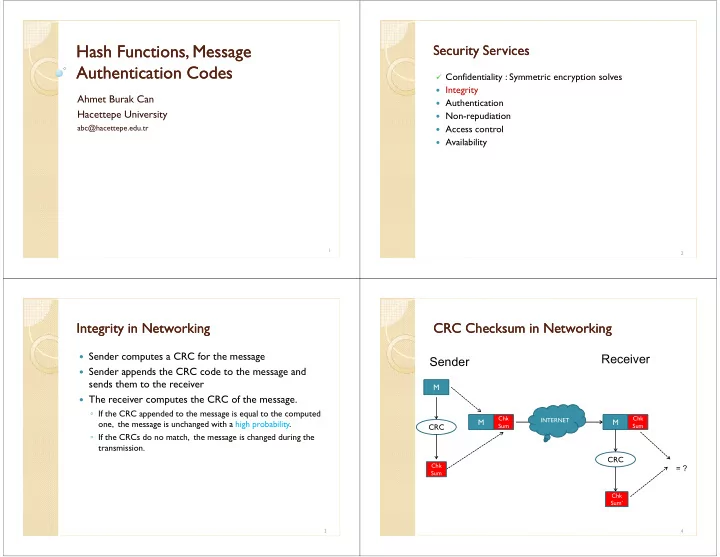

Hash Functions, Message Hash Functions, Message Security Services Security Services Authentication Codes Authentication Codes � Confidentiality : Symmetric encryption solves � Integrity Ahmet Burak Can � Authentication Hacettepe University � Non&repudiation abc@hacettepe.edu.tr � Access control � Availability � Availability 1 2 Integrity in Networking Integrity in Networking CRC Checksum in Networking CRC Checksum in Networking � Sender computes a CRC for the message �������� ������ � Sender appends the CRC code to the message and sends them to the receiver M � The receiver computes the CRC of the message. ◦ If the CRC appended to the message is equal to the computed ◦ If the CRC appended to the message is equal to the computed Chk Chk Chk Chk INTERNET INTERNET M M one, the message is unchanged with a high probability. CRC Sum Sum ◦ If the CRCs do no match, the message is changed during the transmission. CRC Chk ��� Sum Chk Sum’ 3 4
Cryptographic Hash Functions Cryptographic Hash Functions Example Operation of Hash Functions Example Operation of Hash Functions � Maps an arbitrary length input to a fixed&size output. ◦ If m is message, H is the hash function, H(m) is the output of hash function, also called message digest. � Desirable features: ◦ One&way: There should be no easy way to guess m from H(m) ◦ Pseudorandom: If m and m’ are two close values, H(m) and H(m’) should not be close each other. ◦ Collision resistant: It should be hard to find two inputs that hash to the same output � It should be hard to find two inputs � and � such that � ( � ) = � ( � ) 5 6 Birthday Paradox Birthday Paradox Birthday Paradox Birthday Paradox � Birthday Problem (“paradox”): When √N or more are chosen randomly from a domain of N, there is a significant chance of collision. � Probability of n persons having different birthdays: − − � � � � � � � � = × − × − × × − � � � � � � � � � � � ��� � � � ��� ��� ��� 7 8
Collision Resistance Collision Resistance Internals of a Hash Function Internals of a Hash Function � If a hash function produces � bits of output, an attacker � A fixed&size “compression function”. should not easily find a collision by performing less than ◦ Each iteration mixes an input block with the previous output. (on average) 2 � / 2 hash operations. ◦ If there is an easier method than this brute force attack, it is typically considered a flaw in the hash function m = x 1 x 1 y i&1 y i&1 ◦ Therefore, hash output size ≥ 128 bits is desirable. ◦ Therefore, hash output size ≥ 128 bits is desirable. m m compression compression H(m) H(m) x 2 y n y i x i function � But why “collision resistance”? . . . y i&1 ||x i x n ◦ A chosen plaintext attack: Trudy is Alice’s secretary. Generates two opposite messages. � Design: ◦ Lots of operations (rotations, ⊕ , ∧ , ∨ , +, ...) fast in s/w. ◦ More of them are added if a weakness is found. 9 10 Some Popular Hash Algorithms Some Popular Hash Algorithms Message Authentication Codes (MAC) Message Authentication Codes (MAC) � MD5 (Rivest) � A simple message integrity checking method: ◦ 128&bit output ◦ Compute H(m) and send (m, H(m)) ◦ Most popular ◦ The receiver computes H(m) and compares with the received ��������� ����������������� H(m) value. � SHA&1 (NIST &NSA) ��� ��� � What happens if an attacker changes both m and H(m) ����� �� ◦ US gov’t standard US gov’t standard value and sends (m’,H(m’)) to receiver? value and sends (m’,H(m’)) to receiver? ���������� �� ◦ 160&bit output Crypto++ 5.1 benchmarks, 2.1 GHz P4 � RIPEMD&160 � A secret key system can be used to generate a ◦ Euro. RIPE project. cryptographic checksum known as a message ◦ 160&bit output authentication code (MAC). ◦ It is also referred as MIC (Message Integrity Code). 11 12
MACs MACs MACs from Hash Functions MACs from Hash Functions � Let MAC K (m) be a message authentication code for m � prefix: MAC K (m) = H(K || m) produced by using K. ◦ not secure; extension attack. � An attacker shouldn’t be able to generate a valid (m, MAC K (m)), even after seeing many valid message& � suffix: MAC K (m) = H(m || K) MAC pairs. ◦ mostly ok; problematic if H is not collision resistant. mostly ok; problematic if H is not collision resistant. � It aims to protect against undetected modifications on messages, not the contents. � send half of the digest � Sender of a message m computes MAC K (m) and appends it to the message � envelope: MAC K (m) = H(K 1 || m || K 2 ) � Verification: The receiver also computes MAC K (m) & compares to the received value. � HMAC: MAC K (m) = H(K 2 || H(K 1 || m)) ◦ provably secure; popular in Internet standards. 13 14
Recommend
More recommend